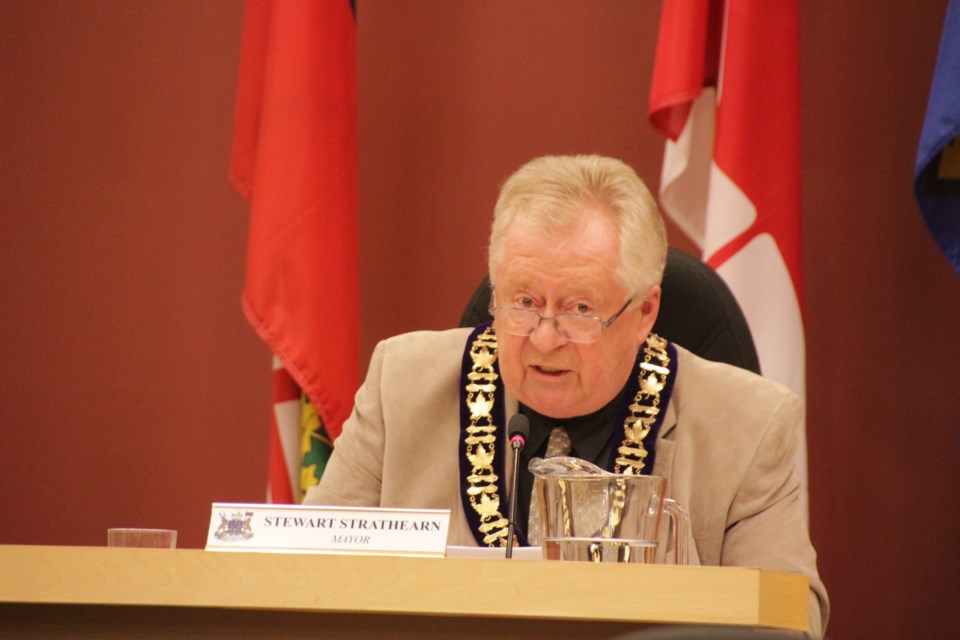The next 30 years are looking to be a population and job growth boom, according to projections by the province, but a county-wide study has Midland’s mayor curious for some clarity on defined boundaries.
Across Simcoe County, a Municipal Comprehensive Review (MCR) exercise is currently underway, intended to bring the official plans for the 16 local area municipalities in Simcoe into conformity with the County Growth Plan, in accordance with the Provincial Growth Plan: A Place To Grow: Growth Plan for the Greater Golden Horseshoe (GPGGH).
The province has required Simcoe County to plan for 555,000 people and 198,000 jobs by 2051, and a land needs assessment to determine growth in existing primary settlement areas is part of the necessary allocation process.
A staff report was brought to a recent meeting of Midland council where Mayor Stewart Strathearn noted that the town had projected a growth to roughly 225,000 by 2030, and asked staff to provide the preliminary allocation numbers required in order to grow that assessment base to 2051.
“I understand that Collingwood, Midland, Penetanguishene, and one other municipality are at the settlement area boundary that corresponds with what this allocation is about,” added Strathearn, “so we’re not likely to see anything in addition in terms of the settlement of the growth area unless we request that.”
Adam Farr, executive director of planning, building and bylaw, explained to council that discussions with the county consulting team would determine those figures, and acknowledged the nuance around land supply within greenfield areas, opening up land for residential development, and the economies of scale to support necessary services.
“One of the key questions that staff are engaging with the county on,” replied Farr, “whether or not there’s sufficient land supply to receive a potential population allocation. That really does strike at the question of whether the settlement area boundaries are set effectively to allow the town to grow.”
Strathearn’s second question specifically asked of Midland’s allocation, and because Midland and neighbouring town Penetanguishene are listed as primary settlement areas in the GPGGH, what the numbers of both towns would be combined.
“The county is treating it as two separate and distinct primary settlement areas,” Farr answered, “going through all the necessary land supply calculations on a discreet basis, not amalgamating the two.
“In terms of the south versus the north, this exercise splits the municipalities -- between those that are GTA-oriented and more Barrie-oriented, would be a simple way of describing it -- as major hubs. So you do see communities like Collingwood, Wasaga Beach, Clearview; those are included in the North Simcoe area along with Midland and other municipalities in the north, compared to other southern municipalities like Bradford West Gwillimbury and Innisfil,” said Farr.
Strathearn noted that the county appeared to be ignoring Schedule 8 in the GPGGH to designate the two towns as a singular settlement area, but left that matter for staff to address.
“It strikes me as a rather interesting inconsistency,” Strathearn stated.
Coun. Bill Gordon, who described the document as “a beast of a report” that's important to both residents and businesses, raised a point to natural heritage site designations within the proposed allotments, but Farr responded that such instances would be reviewed municipally on a case-by-case basis to expend all options before reaching a county level examination.
“I just want to be clear that the current designations that you see on the recently approved Official Plan do not lock down every single acre of naturally designated land,” Farr asserted. “There are mechanisms to assess those and to determine whether there is development potential, but it does raise an element of unpredictability in terms of the exercise that’s going on at the county level now.”
CAO David Denault had the final word, emphasizing the talent of staff brought on board to tackle Midland’s future over the next generation.
“Rest assured this is a really important process that we’re participating in,” said Denault. “We know that growth is really important for Midland for many reasons; primarily, because I think it’s really fundamental to our sustainability.
“We’ve got one of the oldest populations, we know our income levels are one of the lowest in Simcoe, and we need growth both from a jobs perspective and from a residents' perspective.
“So making sure the province and the county understands what Midland has to offer, what Midland is capable of, and also what our needs are is really important," he said. "This is one of those processes where we get to call that out."
Recently, the Township of Tiny also discussed the impact of their projected numbers in North Simcoe as per the MCR exercise, hoping to lower the county density of 32 persons and jobs per hectare down to 12 within the township.
Council meetings are held on the first and third Wednesdays of each month, and can be viewed on Rogers TV cable channel 53, or through the livestream on the Rogers TV website. Archives of council meetings are available through Rogers TV and on the Town of Midland’s YouTube channel.



